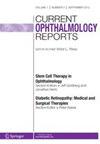局部糖皮质激素治疗非动脉性前缺血性视神经病变的疗效观察
IF 0.8
Q4 OPHTHALMOLOGY
引用次数: 0
摘要
背景:非动脉性前缺血性视神经病变是仅次于青光眼的第二常见视神经病变。糖皮质激素治疗用于非动脉性前缺血性视神经病变治疗的有效性仍然是一个有争议的主题。目前,寻找疾病治疗窗口的标志物正在进行中。目的:本研究的目的是评估局部糖皮质激素治疗作为非动脉性前缺血性视神经病变的急诊护理。材料与方法:41例非动脉性前缺血性视神经病变患者纳入研究。为了评估视神经头和黄斑的形态特征,进行了光学相干断层扫描,并评估了4个血管拱廊的动脉和静脉直径。根据有无肠内积液将患者分为两组。第一组(主要)有视网膜积液患者23例,第二组(对照组)无视网膜积液患者18例。第一组患者根据医疗救助求助期为5天和6 ~ 21天进一步分为2个亚组(亚组19例,亚组2 14例)。结果:视神经头水肿变化动态与动脉直径呈负相关,与静脉直径呈正相关。穴位注射长效糖皮质激素对第一组患者形态功能无明显改善。在疾病急性期完成局部短效糖皮质激素治疗,使第一组患者在第一个月的最佳矫正视力得到改善,而没有进一步恶化。结论:在发病后5天内对非动脉性前缺血性视神经病变患者进行急诊护理时,建议局部使用糖皮质激素治疗。本文章由计算机程序翻译,如有差异,请以英文原文为准。
The efficacy of local glucocorticosteroid therapy in nonarteritic anterior ischemic optic neuropathy
BACKGROUND: Non-arteritic anterior ischemic optic neuropathy is the second most common optic neuropathy after glaucoma. The effectiveness of the glucocorticosteroid therapy use for the non-arteritic anterior ischemic optic neuropathy treatment remains a subject of debate. Currently, the search for markers of the diseases therapeutic window is under way.
AIM: The aim of this study is to evaluate the use of local glucocorticosteroid therapy as an emergency care for non-arteritic anterior ischemic optic neuropathy.
MATERIALS AND METHODS: 41 patients with non-arteritic anterior ischemic optic neuropathy were enrolled in the study. To evaluate optic nerve head and macula morphometric characteristics, optical coherence tomography was performed, additionally, diameters of arteries and veins were assessed at 4 vascular arcades. Patients were divided into 2 groups according to the presence of intraretinal fluid. The first (main) group consisted of 23 patients with intraretinal fluid, in the second (control) group 18 patients without intraretinal fluid were included. The first group was further divided into two subgroups according to the medical aid recourse periods up to 5 days, and from 6 to 21 days (subgroup 1 9 patients, subgroup 2 14 patients).
RESULTS: Correlations between the dynamics of optic nerve head edema changes and the caliber of arteries (negative correlation) and that of veins (positive correlation) were revealed. Sub-tenon injection of long-acting glucocorticosteroid did not lead to morpho-functional improvement in first group patients. Local short-acting glucocorticosteroid therapy accomplished in the acute period of the disease made it possible to achieve an improvement in best corrected visual acuity during the first month in group 1 patients without any further worsening of it.
CONCLUSIONS: When providing emergency care to patients with non-arteritic anterior ischemic optic neuropathy during the first 5 days from the disease onset, the local use of glucocorticosteroid therapy is advisable.
求助全文
通过发布文献求助,成功后即可免费获取论文全文。
去求助
来源期刊

Current Ophthalmology Reports
Medicine-Ophthalmology
CiteScore
2.00
自引率
0.00%
发文量
22
期刊介绍:
This journal aims to offer expert review articles on the most significant recent developments in the field of ophthalmology. By providing clear, insightful, balanced contributions, the journal intends to serve those who diagnose, treat, manage, and prevent ocular conditions and diseases. We accomplish this aim by appointing international authorities to serve as Section Editors in key subject areas across the field. Section Editors select topics for which leading experts contribute comprehensive review articles that emphasize new developments and recently published papers of major importance, highlighted by annotated reference lists. An Editorial Board of more than 20 internationally diverse members reviews the annual table of contents, ensures that topics include emerging research, and suggests topics of special importance to their country/region. Topics covered may include age-related macular degeneration; diabetic retinopathy; dry eye syndrome; glaucoma; pediatric ophthalmology; ocular infections; refractive surgery; and stem cell therapy.
 求助内容:
求助内容: 应助结果提醒方式:
应助结果提醒方式:


